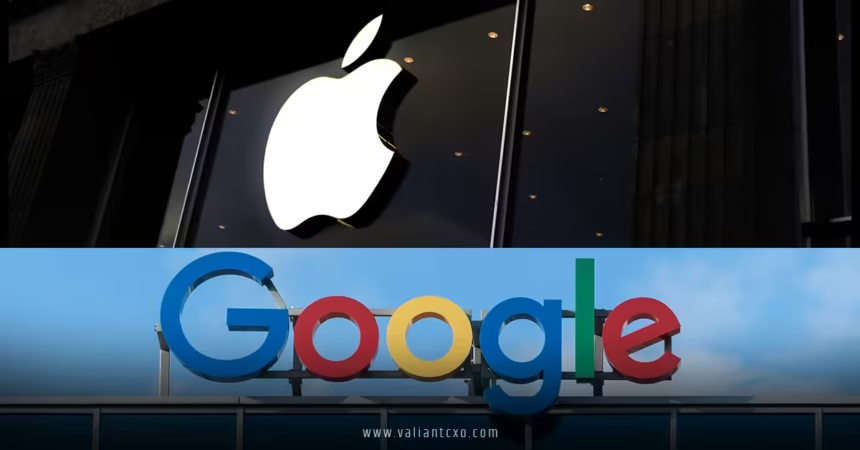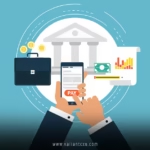US Bank Strategies to Compete with Tech Giants like Apple and Google are more critical now than ever before. Picture this: you’re at a coffee shop, paying for your latte with a tap of your phone via Apple Pay. Or maybe you’re splitting a dinner bill with friends using Google Pay. Tech giants like Apple and Google aren’t just making gadgets or search engines anymore—they’re elbowing their way into the financial services space, and they’re doing it with flair. With massive customer bases, cutting-edge tech, and seamless user experiences, these titans are giving traditional US banks a run for their money. So, how do banks fight back? How do they hold their ground against these digital juggernauts? In this article, we’ll dive deep into the innovative US Bank Strategies to Compete with Tech Giants like Apple and Google, exploring how they’re adapting, innovating, and collaborating to stay relevant in a rapidly evolving financial landscape.
Why Tech Giants Are a Threat to US Banks
Let’s set the stage. Tech giants like Apple, Google, Amazon, and even Meta are no longer just spectators in the financial services game. They’re active players, offering payment systems, digital wallets, and even credit products. Apple Pay has millions of users tapping their iPhones to pay for everything from groceries to gas. Google Pay isn’t far behind, and Amazon’s lending services are making waves. These companies have something banks can only dream of: massive, loyal user bases and troves of consumer data. They know what you buy, where you shop, and even what you search for online. That’s a goldmine for creating personalized financial products that feel like they were made just for you.
But here’s the kicker: tech giants aren’t weighed down by the legacy systems that many banks still wrestle with. They’re agile, innovative, and built for the digital age. For banks, this means the pressure is on to rethink their approach. US Bank Strategies to Compete with Tech Giants like Apple and Google must focus on leveraging their strengths—trust, regulatory expertise, and established customer relationships—while embracing the kind of innovation that tech giants are known for. So, what are these strategies? Let’s break them down.
Embracing Digital Transformation
Modernizing Legacy Systems
Imagine trying to race a Formula 1 car with a horse and buggy. That’s what it’s like for banks with outdated systems trying to keep up with tech giants. Many US banks are saddled with legacy infrastructure—clunky, expensive-to-maintain systems that slow down innovation. To compete, banks are investing heavily in modernizing their tech stacks. For example, transitioning to cloud-based platforms allows banks to scale operations, improve security, and roll out new features faster. By shedding the weight of old systems, banks can move at the speed of tech giants, delivering seamless digital experiences that customers now expect.
Building User-Friendly Digital Platforms
Have you ever tried to navigate a bank’s website and felt like you needed a PhD to find your account balance? Tech giants have set the bar high with intuitive, user-friendly interfaces. US Bank Strategies to Compete with Tech Giants like Apple and Google include revamping their digital platforms to prioritize ease of use. Mobile apps with features like instant transfers, mobile check deposits, and real-time budgeting tools are becoming standard. Banks like Ally and Discover have led the charge here, offering sleek, no-fee digital banking experiences that rival the simplicity of tech giants’ offerings.
Leveraging Data for Hyper-Personalization
Using AI and Analytics for Tailored Experiences
If there’s one thing tech giants do better than anyone, it’s using data to personalize experiences. Ever notice how Google seems to know exactly what ad to show you? Banks are catching up by harnessing artificial intelligence (AI) and advanced analytics. By analyzing customer data—spending habits, saving patterns, life milestones—banks can offer hyper-personalized products. For instance, a bank might suggest a tailored savings plan for a customer planning a wedding or recommend a mortgage product to someone browsing home listings. These US Bank Strategies to Compete with Tech Giants like Apple and Google turn data into a tool for building stronger customer relationships.
Predictive Analytics to Prevent Churn
Losing customers to tech giants is a real risk. Why stick with a bank when Apple Card offers a slick interface and cashback rewards? To combat this, banks are using predictive analytics to spot early signs of customer churn. By identifying patterns—like reduced account activity or frequent complaints—banks can step in with targeted offers or improved services to keep customers loyal. This proactive approach is a cornerstone of US Bank Strategies to Compete with Tech Giants like Apple and Google, ensuring banks stay one step ahead of customer needs.
Collaborating with Fintechs and Tech Giants
Partnering for Innovation
Here’s a plot twist: instead of fighting tech giants head-on, some banks are teaming up with them. Collaborations allow banks to tap into the tech giants’ innovation while bringing their own strengths to the table, like regulatory expertise and customer trust. A prime example is Goldman Sachs partnering with Apple to launch the Apple Card. This partnership combines Goldman’s financial know-how with Apple’s user experience expertise, creating a product that’s tough to beat. US Bank Strategies to Compete with Tech Giants like Apple and Google often involve these strategic alliances, blending the best of both worlds to deliver cutting-edge financial products.
Acquiring Fintech Startups
Why build from scratch when you can buy innovation? Many banks are acquiring fintech startups to fast-track their digital transformation. Citibank, for instance, has snapped up multiple fintechs to bolster its digital offerings. These acquisitions bring fresh ideas, agile tech, and new talent into the fold, helping banks close the gap with tech giants. By integrating fintech solutions, banks can offer innovative services like instant loans or fee-free banking, making them more competitive in a crowded market.
Prioritizing Customer Trust and Security
Capitalizing on the Trust Gap
Tech giants may have cool apps, but banks have something they don’t: centuries of trust. Consumers might hesitate to hand over their life savings to a company best known for selling phones or running social media platforms. US Bank Strategies to Compete with Tech Giants like Apple and Google lean heavily on this trust advantage. Banks emphasize their robust security measures, regulatory compliance, and long-standing reputation to reassure customers. By highlighting their track record, banks can position themselves as the safer choice for managing money.
Enhancing Cybersecurity Measures
With cyber threats on the rise, security is a top concern for customers. Banks are doubling down on cybersecurity, implementing tools like two-factor authentication, biometric logins, and AI-driven fraud detection. These measures not only protect customers but also reinforce the trust gap between banks and tech giants. After all, would you rather trust your money with a bank that’s been safeguarding funds for decades or a tech company that’s still figuring out the financial services game?
Offering Competitive Products and Rates
Matching Tech Giants’ Innovation
Tech giants are shaking up the market with innovative products like Apple Card’s cashback rewards or Google Pay’s seamless payment integrations. To keep up, banks are rolling out their own competitive offerings. For example, many are introducing high-yield savings accounts, no-fee checking, and instant loan approvals to match the convenience of tech giants’ products. US Bank Strategies to Compete with Tech Giants like Apple and Google hinge on offering products that are just as attractive, if not more so, to today’s tech-savvy consumers.
Streamlining Account Opening Processes
Ever tried signing up for a new bank account and felt like you were applying for a top-secret government job? Tech giants have made account openings lightning-fast, and banks are taking note. By simplifying their processes—think fewer forms and faster approvals—banks can match the convenience that tech giants offer. Ally Bank, for instance, lets customers open accounts in minutes through its mobile app, a move that aligns with US Bank Strategies to Compete with Tech Giants like Apple and Google.
Investing in Omnichannel Experiences
Seamless Integration Across Touchpoints
Today’s customers want to bank on their terms—whether that’s on a mobile app, a website, or in a branch. Tech giants excel at creating seamless experiences across their platforms, and banks are following suit with omnichannel strategies. This means ensuring that whether a customer starts a transaction on their phone or finishes it at an ATM, the experience is consistent and hassle-free. US Bank Strategies to Compete with Tech Giants like Apple and Google prioritize this seamless integration to keep customers engaged across all channels.
Enhancing In-Branch Experiences
While tech giants focus on digital, many banks still see value in physical branches. Why? Because some customers—especially older generations—still prefer face-to-face interactions. Banks are upgrading their branches with digital tools like interactive kiosks and personalized consultations, blending the best of digital and in-person experiences. This hybrid approach is a key part of US Bank Strategies to Compete with Tech Giants like Apple and Google, ensuring banks cater to all customer preferences.
Boosting Digital Marketing and SEO
Building a Strong Online Presence
When was the last time you Googled a bank before opening an account? Probably recently. Customers research online, and banks need to show up where it counts. US Bank Strategies to Compete with Tech Giants like Apple and Google include ramping up digital marketing efforts. This means optimizing websites for search engines, creating engaging content like financial tips or success stories, and maintaining active social media presences on platforms like Instagram and LinkedIn. By boosting their SEO game, banks can attract organic traffic and compete with tech giants’ massive online reach.
Using Social Media to Engage Customers
Tech giants are social media masters, but banks are learning fast. By sharing relatable content—think money-saving tips or behind-the-scenes looks at bank initiatives—banks can connect with younger audiences. US Bank’s “Power of Possible” campaign, for example, uses social media to inspire customers to achieve their financial goals. These efforts are a vital part of US Bank Strategies to Compete with Tech Giants like Apple and Google, helping banks build brand loyalty in a digital-first world.
Exploring Embedded Finance and Ecosystems
Integrating Financial Services into Everyday Life
Imagine booking a ride on Uber and managing your finances in the same app. That’s the power of embedded finance, and tech giants are all over it. Banks are fighting back by partnering with non-financial platforms to integrate their services into daily life. For example, a bank might team up with a retailer to offer instant loans at checkout. These US Bank Strategies to Compete with Tech Giants like Apple and Google make banking as seamless as ordering a pizza, embedding financial services into customers’ everyday routines.
Creating Open Banking Ecosystems
Open banking is the future, and banks are embracing it to stay competitive. By using APIs (application programming interfaces), banks can share data with third-party providers to create new services. BBVA’s API Market, for instance, allows developers to build innovative financial tools that integrate with the bank’s systems. This open ecosystem approach is a cornerstone of US Bank Strategies to Compete with Tech Giants like Apple and Google, enabling banks to stay agile and customer-focused.
Conclusion
US Bank Strategies to Compete with Tech Giants like Apple and Google are all about playing to their strengths while embracing innovation. By modernizing systems, leveraging data, collaborating with fintechs, and prioritizing trust, banks are holding their own against the digital titans. They’re offering competitive products, streamlining processes, and building seamless omnichannel experiences that rival the convenience of tech giants. Plus, with smart digital marketing and embedded finance, banks are finding new ways to stay relevant. The financial landscape is changing, but US banks are proving they’ve got the chops to compete. So, whether you’re a customer or a banking professional, keep an eye on these strategies—they’re shaping the future of finance. Ready to see how banks can outsmart the tech giants? Stay curious and watch this space!
FAQs
1. How are US Bank Strategies to Compete with Tech Giants like Apple and Google different from traditional banking approaches?
US Bank Strategies to Compete with Tech Giants like Apple and Google focus on digital transformation, hyper-personalization, and partnerships with fintechs or tech giants. Unlike traditional banking, which relied heavily on physical branches and standardized products, these strategies prioritize seamless digital experiences, data-driven personalization, and innovative collaborations to match the agility of tech giants.
2. Why do tech giants like Apple and Google pose a threat to US banks?
Tech giants have massive customer bases, advanced technology, and vast amounts of consumer data, allowing them to offer personalized financial products like Apple Pay or Google Pay. Their agility and lack of legacy systems make them formidable competitors, pushing banks to adopt US Bank Strategies to Compete with Tech Giants like Apple and Google to stay relevant.
3. How can US banks use data to compete with tech giants?
Banks can use AI and predictive analytics to analyze customer behavior and offer tailored financial products, like customized savings plans or loan offers. These data-driven US Bank Strategies to Compete with Tech Giants like Apple and Google help banks deliver personalized experiences that rival the tech giants’ offerings.
4. What role do partnerships play in US Bank Strategies to Compete with Tech Giants like Apple and Google?
Partnerships with fintechs or even tech giants allow banks to combine their regulatory expertise and trust with cutting-edge technology. For example, Goldman Sachs partnered with Apple for the Apple Card. Such collaborations are key US Bank Strategies to Compete with Tech Giants like Apple and Google, enabling banks to innovate faster.
5. How do US banks build trust to compete with tech giants?
Banks leverage their long-standing reputation for security and regulatory compliance, emphasizing robust cybersecurity measures like biometric logins and fraud detection. By highlighting this trust gap, US Bank Strategies to Compete with Tech Giants like Apple and Google reassure customers that their money is safe with traditional banks.
For More Updates !! : valiantcxo.com


